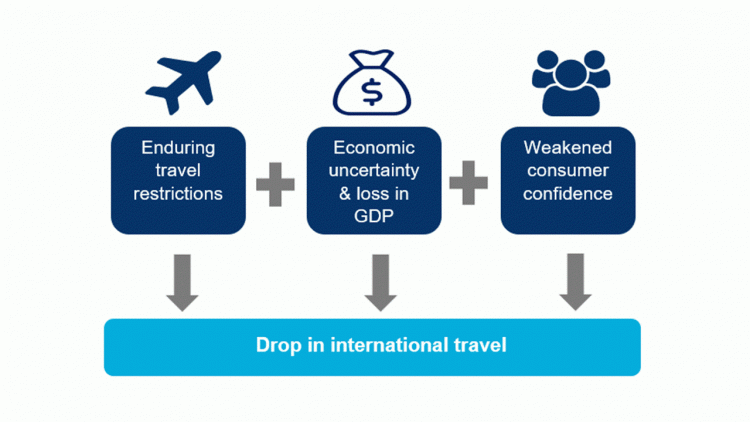
Sarah-Jane Trimble, Economist
Sarah-Jane primarily works on Tourism Economics forecast databases including Global Travel Service (GTS) and Global City Travel (GCT)
The coronavirus outbreak is having a drastic impact on travel and tourism, with countries across the world implementing some of the strictest travel restrictions ever seen. Consumers are suffering from a weakened economic backdrop, which has generated greater income and unemployment uncertainty. Therefore, we forecast a 52% drop in global travel in 2020. However, vast uncertainty surrounds the current travel outlook as the scale and duration of the downturn remain unknown as well as the pace of recovery.
We have identified three broad areas of uncertainty in modelling the tourism outlook:

Therefore, we have created alternative scenarios to reflect this uncertainty and show the plausible range of forecasts facing the tourism industry.
Our baseline forecast is that some international travel restrictions will be lifted over the summer months, with travel from short-haul markets eased first, followed by other regional markets before long-haul travel is allowed. This profile is indicated in the travel restriction stringency index which we have calculated for all countries under a set of baseline assumptions as well as under alternative upside and downside assumptions.
In the upside scenario, global travel would fall by close to 40% in 2020, facilitated by a shorter duration of negative impact, at eight months, with the most severe impacts occurring in the first half of this period. In this scenario, we assume a more rapid easing of restrictions combined with a faster economic recovery which would enable a quicker rebound in traveler sentiment.

Sarah-Jane Trimble, Economist
Sarah-Jane primarily works on Tourism Economics forecast databases including Global Travel Service (GTS) and Global City Travel (GCT)
However, a large downside risk to the travel outlook remains as travel and other lock-down measures may be required for longer and in some cases may need to be re-imposed if there is a second wave of the virus. In the downside scenario, restrictions will be required in some form for 18 months which would intensify the current difficulties facing the travel industry, making it more difficult to stimulate travel demand.
Moreover, a weaker economic backdrop is assumed which would inevitably lead to additional business closures and greater job losses. Consumer confidence would therefore take an even greater hit in this scenario due to stringent travel restrictions and a weakened economic outlook, further depressing traveler sentiment and lengthening the recovery in travel demand.